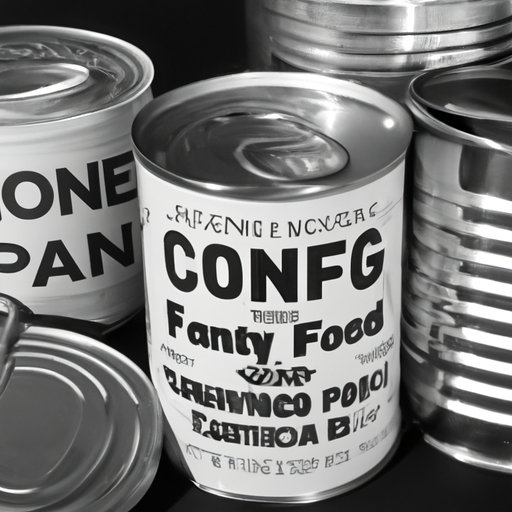Introduction
Canned food is one of the most convenient, affordable, and widely available sources of sustenance in the world. But when was canned food invented? This article seeks to answer this question by exploring the history and impact of canned food. We will look at the origins of canned food, examine its evolution over the centuries, and explore how it has shaped global eating habits and impacted cuisine, nutrition, and health.

A History of Canned Food: Exploring the Invention and Early Uses
The concept of preserving food for long-term storage has been around since ancient times. According to a study published in the International Journal of Food Science & Technology, “the practice of preserving food through dehydration, salting, smoking, pickling, or fermentation dates back to prehistoric times.”
However, the invention of canned food as we know it today is credited to French confectioner Nicolas Appert. In 1810, Appert developed a method of preserving food in sealed glass jars, subsequently winning a prize offered by the French government for a way to preserve food for military use. The following year, Appert published a book on the process of preserving food, which he called “The Art of Preserving Animal and Vegetable Substances for Several Years.”
Timeline of Canned Food: From Inception to Contemporary Uses
The invention of canned food marked the start of a long journey that would eventually lead to the mass production of canned goods. Here is a brief timeline of the major milestones in the evolution of canned food:
- 1810: Nicolas Appert develops a method of preserving food in sealed glass jars.
- 1812: Appert publishes a book on the process of preserving food.
- 1819: Peter Durand patents the first tin can.
- 1825: The first commercial cannery opens in England.
- 1858: The first U.S. cannery opens in New York.
- 1870s: Canning technology advances, leading to the mass production of canned goods.
Today, canned food is ubiquitous, with an estimated 80 billion cans produced worldwide each year.

The Science Behind the Invention of Canned Food
Canning is a complex process that involves several scientific principles. At its core, canning is a form of heat treatment. According to the USDA, “heat treatment destroys microorganisms that cause spoilage and can be used to can low-acid foods safely.” The process also involves airtight sealing and the use of preservatives such as salt and sugar to extend the shelf life of canned goods.
The benefits of canning are numerous. The airtight sealing of cans prevents the contamination of food by outside bacteria, while the heat treatment and preservatives help to kill off any bacteria already present in the food. In addition, canned food has a longer shelf life than fresh food, making it easier to transport and store.

How the Invention of Canned Food Changed Eating Habits Across the Globe
The invention of canned food had a profound effect on global eating habits. Prior to the invention of canning, food was often scarce and had to be consumed shortly after harvest. With the advent of canning, food could be stored for long periods of time, allowing for the global expansion of canned food.
Canned food also changed the way people ate. It allowed for the creation of quick, easy meals that could be made with minimal effort. This revolutionized home cooking, paving the way for the introduction of convenience foods such as canned soup and ready-made meals.
Exploring the Impact of Canned Food on Cuisine, Nutrition, and Health
The invention of canned food had a significant impact on cuisine, nutrition, and health. Canned food is often cheaper and more readily available than fresh produce, making it an attractive option for those on a budget. Furthermore, canned food is often fortified with vitamins and minerals, providing a convenient source of essential nutrients.
In terms of cuisine, canned food has revolutionized the way we cook. Canned tomatoes, beans, and other ingredients have become staples in many dishes, from chili to ratatouille. In addition, canned fish such as tuna and salmon are popular ingredients in salads and sandwiches.
Finally, canned food has had a positive impact on health. Studies have shown that canned fruit and vegetables can provide the same nutritional benefits as their fresh counterparts. Additionally, canned food often contains fewer additives and preservatives than processed foods, making it a healthier option.
Conclusion
The invention of canned food was revolutionary, changing the way we eat and introducing new culinary possibilities. Canned food has made food more accessible, providing a convenient and affordable source of sustenance. In addition, canned food is often fortified with vitamins and minerals, making it a nutritious option. Ultimately, the invention of canned food has had a lasting impact on modern life.
(Note: Is this article not meeting your expectations? Do you have knowledge or insights to share? Unlock new opportunities and expand your reach by joining our authors team. Click Registration to join us and share your expertise with our readers.)
